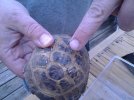Hi my name is Pete, I'm 44 and I live in Michigan. I've kept turtles since I was 19 and have had pancake tortoises, but mostly Russians as they are cheaper and hardier.
I've noticed one of my male Russian tortoises has developed a sunken area on a spinal scute, 2nd from the bottom. I feed them a diet of romaine(rarely), collard, mustard, turnip, dandelion greens. They were out a couple of cold nights and I'm worried the cold damp nights of michigan may have caused harm to them. He is still active & eating. Any info would be great. Thank You
I've noticed one of my male Russian tortoises has developed a sunken area on a spinal scute, 2nd from the bottom. I feed them a diet of romaine(rarely), collard, mustard, turnip, dandelion greens. They were out a couple of cold nights and I'm worried the cold damp nights of michigan may have caused harm to them. He is still active & eating. Any info would be great. Thank You

